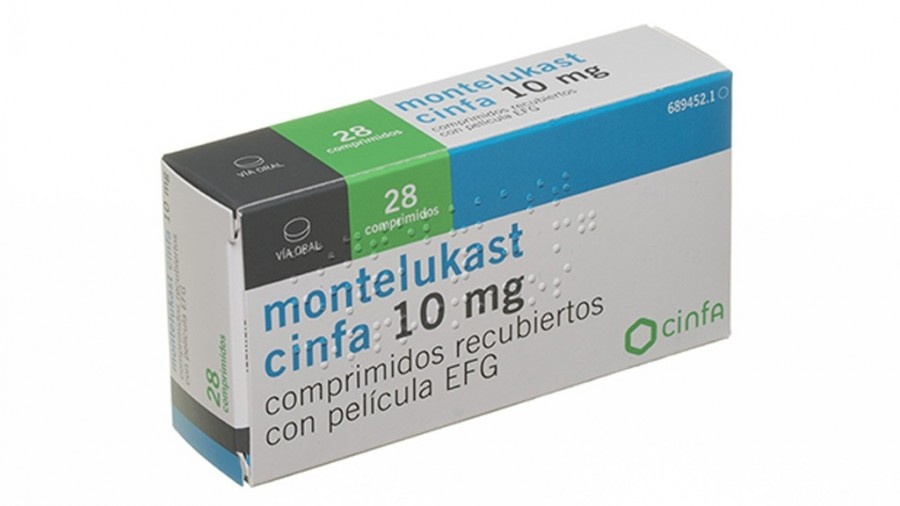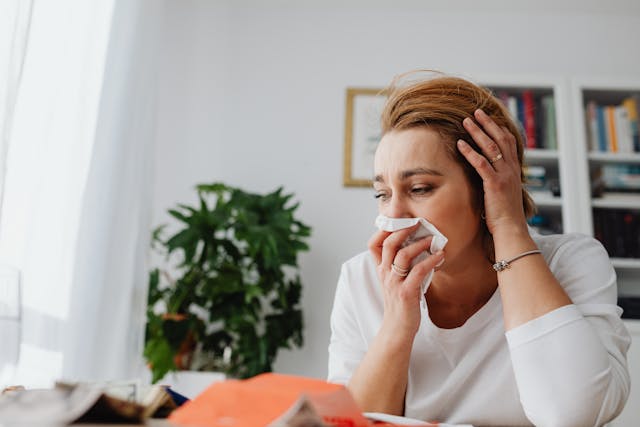

MONTELUKAST UR 10 mg FILM-COATED TABLETS

Ask a doctor about a prescription for MONTELUKAST UR 10 mg FILM-COATED TABLETS

How to use MONTELUKAST UR 10 mg FILM-COATED TABLETS
Introduction
Package Leaflet: Information for the User
Montelukast UR 10 mg film-coated tablets EFG
Read the package leaflet carefully before your child starts taking this medicine because it contains important information for you.
- Keep this package leaflet, you may need to read it again.
- If you have any further questions, ask your doctor, pharmacist, or nurse.
- This medicine has been prescribed to your child, do not give it to others, even if they have the same symptoms as your child, as it may harm them.
- If your child experiences side effects, consult your doctor or pharmacist, even if they are side effects not mentioned in this package leaflet. See section 4.
Contents of the package leaflet:
- What is Montelukast UR and what is it used for
- What you need to know before taking Montelukast UR
- How to take Montelukast UR
- Possible side effects
- Storage of Montelukast UR
- Contents of the pack and further information
1. What is Montelukast UR and what is it used for
Montelukast is a leukotriene receptor antagonist that blocks substances called leukotrienes. Leukotrienes cause narrowing and swelling of the airways in the lungs and can also cause allergy symptoms. By blocking leukotrienes, Montelukast UR improves asthma symptoms, helps control asthma, and improves symptoms of seasonal allergies (also known as hay fever or seasonal allergic rhinitis).
Your doctor has prescribed Montelukast UR to treat asthma and prevent asthma symptoms during the day and night.
- Montelukast UR is used for the treatment of patients who are not adequately controlled with their medication and need additional treatment.
- Montelukast UR also helps prevent narrowing of the airways caused by exercise.
- In asthmatic patients with Montelukast UR indicated for the treatment of asthma, Montelukast UR 10 mg may also provide relief from symptoms of seasonal allergic rhinitis.
Depending on your child's symptoms and the severity of their asthma, your doctor will determine how to use Montelukast UR.
What is asthma?
Asthma is a chronic disease.
Asthma includes:
• Difficulty breathing due to narrowing of the airways. This narrowing of the airways worsens and improves in response to various diseases.
- Airways that are sensitive to many things, such as cigarette smoke, pollen, cold air, or exercise.
- Swelling (inflammation) of the inner layer of the airways. Asthma symptoms include: Coughing, wheezing, and chest congestion.
What are seasonal allergies?
Seasonal allergies (also known as hay fever or seasonal allergic rhinitis) are an allergic response often caused by airborne pollen from trees, grass, and weeds. Symptoms of seasonal allergies typically include: Stuffy nose, runny nose, itchy nose, sneezing; watery, swollen, red, and itchy eyes.
2. What you need to know before taking Montelukast UR
Tell your doctor about any allergy or medical problem you have now or have had.
Do not take Montelukast UR if:
- you are allergic to Montelukast or any of the other ingredients of this medicine (listed in section 6).
Warnings and precautions:
- If your child's asthma or breathing worsens, tell your doctor immediately.
- Montelukast oral is not indicated for the treatment of acute asthma attacks. If an attack occurs, follow the instructions your doctor has given you for your child. Always have your child's rescue inhaler medication for asthma attacks.
- It is essential to use all asthma medications prescribed by your doctor. Montelukast UR should not replace other asthma medications your doctor has prescribed.
- If you are being treated with asthma medications, be aware that if you develop a combination of symptoms such as flu-like illness, tingling or numbness of arms or legs, worsening of lung symptoms, and/or skin rash, you should consult your doctor.
- Do not take acetylsalicylic acid (aspirin) or anti-inflammatory medications (also known as non-steroidal anti-inflammatory drugs or NSAIDs) if they worsen your asthma.
Use in children:
Montelukast UR is indicated for patients 15 years of age and older.
For children 6 to 14 years old, Montelukast UR 5 mg chewable tablets are available. For children 2 to 5 years old, Montelukast UR 4 mg chewable tablets are available.
Use of other medications:
Some medications may affect the functioning of Montelukast UR, or Montelukast UR may affect the functioning of other medications you are taking.
Tell your doctor or pharmacist if you are taking or have recently taken any other medications, including those obtained without a prescription.
Before taking Montelukast UR, tell your doctor if you are taking the following medications:
- phenobarbital (used to treat epilepsy)
- phenytoin (used to treat epilepsy)
- rifampicin (used to treat tuberculosis and some other infections)
Taking Montelukast UR with food and drinks:
Montelukast UR can be taken with or without food.
Pregnancy and breastfeeding:
Pregnancy:
Women who are pregnant or plan to become pregnant should consult their doctor before taking Montelukast UR. Your doctor will assess whether you can take Montelukast UR during this period.
Breastfeeding:
It is unknown whether Montelukast is excreted in breast milk. If you are breastfeeding or plan to breastfeed, consult your doctor before taking Montelukast UR.
Driving and using machines:
Montelukast is not expected to affect your ability to drive a car or operate machinery. However, individual responses to the medication may vary. Certain side effects (such as dizziness and drowsiness) that have been reported very rarely with Montelukast may affect the patient's ability to drive or operate machinery.
Important information about some of the ingredients of Montelukast UR:
This medicine contains lactose. If your doctor has told you that you have an intolerance to certain sugars, consult with them before taking this medicine.
3. How to take Montelukast UR
- Always take Montelukast UR exactly as your doctor has told you. Check with your doctor or pharmacist if you are not sure.
- The usual dose is one Montelukast UR tablet once daily as prescribed by your doctor.
- It should be taken even when your child does not have symptoms or during an acute asthma attack.
- It should be taken orally.
For children 15 years of age and older:
One Montelukast UR tablet at night. The film-coated tablet should be swallowed with a sufficient amount of liquid (e.g., water). Montelukast UR can be taken with or without food.
If you are taking Montelukast UR, make sure you do not take any other medication that contains the same active ingredient, Montelukast.
If you take more Montelukast UR than you should:
Seek immediate medical attention from your child's doctor.
In most cases of overdose, no side effects were reported. The symptoms that occurred most frequently in overdose in adults and children were abdominal pain, drowsiness, thirst, headache, vomiting, and hyperactivity.
In case of overdose or accidental ingestion, consult your doctor or pharmacist immediately or call the Toxicology Information Service, phone: 91 562 04 20, indicating the medicine and the amount taken.
If you forget to take Montelukast UR:
Try to take Montelukast UR as prescribed. However, if you miss a dose, just resume your regular schedule of one tablet once daily.
Do not take a double dose to make up for missed doses.
If you stop taking Montelukast UR:
Montelukast UR can only treat asthma if you continue taking it.
It is essential to continue taking Montelukast UR for as long as your doctor prescribes it. It will help control your child's asthma.
If you have any further questions about the use of this product, ask your doctor or pharmacist.
4. Possible side effects
Like all medicines, Montelukast UR can cause side effects, although not everybody gets them.
Possible side effects are listed according to the following categories:
Very common side effects (may affect more than 1 in 10 people)
Common side effects (may affect up to 1 in 10 people)
Uncommon side effects (may affect up to 1 in 100 people)
Rare side effects (may affect up to 1 in 1,000 people)
Very rare side effects (may affect up to 1 in 10,000 people)
Side effects of unknown frequency (cannot be estimated from the available data)
In clinical trials with Montelukast, the side effects related to the administration of the medicine and most frequently reported (occurring in at least 1 in 100 patients and less than 1 in 10 patients treated) were:
- abdominal pain
- headache
These side effects were generally mild and occurred with a higher frequency in patients treated with Montelukast than with placebo (a pill that does not contain medicine).
Additionally, since the medicine has been marketed, the following side effects have been reported:
- upper respiratory tract infection
- increased risk of bleeding
- allergic reactions including skin rash, swelling of the face, lips, tongue, and/or throat that may cause difficulty breathing or swallowing
- behavioral and mood changes [sleep disturbances, including nightmares, hallucinations, irritability, feeling anxious, restlessness, including aggressive or hostile behavior, tremor, depression, sleep problems, sleepwalking, suicidal thoughts and actions (in very rare cases)]
- dizziness, drowsiness, tingling/numbness, seizures
- palpitations
- nasal bleeding
- diarrhea, dry mouth, indigestion, nausea, vomiting
- hepatitis (inflammation of the liver)
- bruises, itching, hives, painful red lumps under the skin that most frequently appear on the shins (erythema nodosum)
- joint or muscle pain, muscle cramps
- fatigue, discomfort, swelling, fever
In asthmatic patients treated with Montelukast, very rare cases of a combination of symptoms such as flu-like illness, tingling or numbness of arms and legs, worsening of lung symptoms, and/or skin rash (Churg-Strauss syndrome) have been reported. You should immediately inform your doctor if your child has one or more of these symptoms.
Ask your doctor or pharmacist for more information about side effects. If you experience any side effect that is severe or if you notice any side effects not mentioned in this package leaflet, inform your child's doctor or pharmacist.
Reporting of side effects:
If you experience any side effects, consult your doctor or pharmacist, even if they are side effects not mentioned in this package leaflet. You can also report them directly through the national reporting system: www.notificaRAM.es. By reporting side effects, you can help provide more information on the safety of this medicine.
5. Storage of Montelukast UR 10 mg
- Keep this medicine out of the sight and reach of children.
- Do not use this medicine after the expiry date which is stated on the carton after EXP. The expiry date is the last day of the month shown.
- Store in the original package to protect from light and moisture.
Medicines should not be disposed of via wastewater or household waste. Place the packaging and any unused medicine in the SIGRE collection point at your usual pharmacy. Ask your pharmacist how to dispose of the packaging and any unused medicine. This will help protect the environment.
6. Contents of the pack and further information
Composition of Montelukast:
- The active ingredient is Montelukast.
Each tablet contains 10.4 mg of Montelukast sodium, which is equivalent to 10 mg of Montelukast.
- The other ingredients are:
Lactose monohydrate (130.6 mg), microcrystalline cellulose, croscarmellose sodium, magnesium stearate, and anhydrous colloidal silica.
Coating: hypromellose, hypromellose (E-463), titanium dioxide (E-171), red and yellow iron oxide (E-172).
Appearance of the product and contents of the pack:
Montelukast UR 10 mg film-coated tablets are pale pink-yellow, round, biconvex with "M10" engraved on one side.
Montelukast UR 10 mg is available in packs of 28 tablets.
Marketing authorization holder and manufacturer:
Marketing authorization holder:
Aristo Pharma Iberia, S.L.
c/ Solana, 26
28850 – Torrejon de Ardoz. (Madrid) Spain
Manufacturer:
Siegfried Generics Malta Ltd.
HHF070 Hal Far Industrial Estate, (PO Box 14), BBG 3000 Hal Far
Malta
Or
Laboratorios de Medicamentos Internacionales, S.A.
C/ Solana, 26
28850, Torrejón de Ardoz
Madrid, Spain
This package leaflet was approved in April 2011.
Detailed and up-to-date information on this medicine is available on the website of the Spanish Agency for Medicines and Health Products (AEMPS) http://www.aemps.es.

How much does MONTELUKAST UR 10 mg FILM-COATED TABLETS cost in Spain ( 2025)?
The average price of MONTELUKAST UR 10 mg FILM-COATED TABLETS in December, 2025 is around 21.06 EUR. Prices may vary depending on the region, pharmacy, and whether a prescription is required. Always check with a local pharmacy or online source for the most accurate information.
- Country of registration
- Average pharmacy price21.06 EUR
- Active substance
- Prescription requiredYes
- Manufacturer
- This information is for reference only and does not constitute medical advice. Always consult a licensed doctor before taking any medication. Oladoctor is not responsible for medical decisions based on this content.
- Alternatives to MONTELUKAST UR 10 mg FILM-COATED TABLETSDosage form: TABLET, 10 mgActive substance: montelukastManufacturer: Krka D.D. Novo MestoPrescription requiredDosage form: CHEWABLE TABLET, 4 mgActive substance: montelukastManufacturer: Krka D.D. Novo MestoPrescription requiredDosage form: CHEWABLE TABLET, 5 mgActive substance: montelukastManufacturer: Krka D.D. Novo MestoPrescription required
Alternatives to MONTELUKAST UR 10 mg FILM-COATED TABLETS in other countries
The best alternatives with the same active ingredient and therapeutic effect.
Alternative to MONTELUKAST UR 10 mg FILM-COATED TABLETS in Poland
Alternative to MONTELUKAST UR 10 mg FILM-COATED TABLETS in Ukraine
Online doctors for MONTELUKAST UR 10 mg FILM-COATED TABLETS
Discuss dosage, side effects, interactions, contraindications, and prescription renewal for MONTELUKAST UR 10 mg FILM-COATED TABLETS – subject to medical assessment and local rules.















